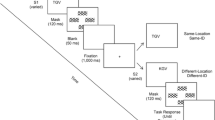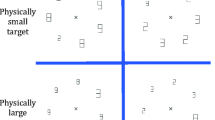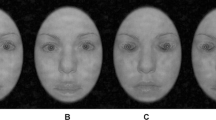Abstract
A modification of the compound stimuli paradigm has been used to measure the impact of a certain single element on the local-to-global effect and to compare the measured impacts of central and non-central elements matched on diagnosticity. In addition to global letters made of identical response-associated elements, some global letters comprised of only one response-associated element at a specific location (with all other ones being response-neutral), and in some other global letters that critical element was rather response-neutral (with all other ones being response-associated). Experiment 1 showed that the contribution of a central element that served as a distinctive feature was as large as the joint contribution of all other elements. Experiment 2 (as well as Experiment 4) showed that, in contrast, a non-central element that served as a distinctive feature did not contribute at all to the effect. Experiment 3 showed that the contribution of a central element was still as large as the joint contribution of all other elements even when it was completely irrelevant for selecting the response.







Similar content being viewed by others
References
Amirkhiabani, G., & Lovegrove, W. J. (1996). Role of eccentricity and size in the global precedence effect. Journal of Experimental Psychology: Human Perception and Performance, 22, 1434–1447.
Amirkhiabani, G., & Lovegrove, W. J. (1999). Do the global advantage and interference effects covary? Perception and Psychophysics, 61, 1308–1319.
Blanca, M. J., Luna, R., Lopez-Montiel, D., Zalabardo, B., & Rando, C. (2002). Effect of the similarity between target and global and local levels in hierarchical stimulus processing. Psychological Research, 66, 124–132.
Boer, L. C., & Keuss, P. J. C. (1982). Global precedence as a postperceptual effect: An analysis of speed-accuracy tradeoff functions. Perception and Psychophysics, 31, 358–366.
Enns, J. T., & Kingstone, A. (1995). Access to global and local properties in visual search for compound stimuli. Psychological Science, 6, 283–291.
Fink, G. R., Halligan, P. W., Marshall, J. C., Frith, C. D., Frackowiak, R. S. J., & Dolan, R. J. (1996). Where in the brain does visual attention select the forest and the trees? Nature, 382, 626–628.
Fink, G. R., Marshall, J. C., Halligan, P. W., Frith, C. D., Frackowiak, R. S. J., & Dolan, R. J. (1997). Hemispheric specialization for global and local processing: The effect of stimulus category. Proceedings of the Royal Society, 264, 487–494.
Grice, G. R., Canham, L., & Boroughs, J. M. (1983). Forest before trees? It depends where you look. Perception and Psychophysics, 33, 121–128.
Han, S., Humphreys, G. W., & Chen, L. (1999). Parallel and competitive processes in hierarchical analysis: Perceptual grouping and encoding of closure. Journal of Experimental Psychology: Human Perception and Performance, 25, 1411–1432.
Hoffman, J. E. (1980). Interaction between global and local levels of a form. Journal of Experimental Psychology: Human Perception and Performance, 6, 222–234.
Hughes, H. C., Layton, W. M., Baird, J. C., & Lester, L. S. (1984). Global precedence in visual pattern recognition. Perception and Psychophysics, 35, 361–371.
Kimchi, R. (1992). The primacy of wholistic processing and the global/local paradigm: A critical review. Psychological Bulletin, 112, 24–38.
Kimchi, R., & Palmer, S. E. (1982). Form and texture in hierarchically constructed patterns. Journal of Experimental Psychology: Human Perception and Performance, 8, 521–535.
Kinchla, R. A., & Wolfe, J. M. (1979). The order of visual processing: Top-down, bottom-up, or middle-out. Perception and Psychophysics, 25, 225–231.
LaGasse, L. L. (1993). Effects of good form and spatial frequency on global precedence. Perception and Psychophysics, 53, 89–105.
Lamb, M. R., & Robertson, L. C. (1988). The processing of hierarchical stimuli: Effects of retinal locus, locational uncertainty, and stimulus identity. Perception and Psychophysics, 44, 172–181.
Lamb, M. R., & Robertson, L. C. (1989). Do response time advantage and interference reflect the order of processing of global- and local-level information? Perception and Psychophysics, 46, 254–258.
Lamb, M. R., & Robertson, L. C. (1990). The effect of visual angle on global and local reaction times depends on the set of visual angles presented. Perception and Psychophysics, 47, 489–496.
Lamb, M. R., Yund, E. W., & Pond, H. M. (1999). Is attentional selection to different levels of hierarchical structure based on spatial frequency? Journal of Experimental Psychology: General, 128, 88–94.
Lasaga, M. I. (1989). Gestalts and their components: Nature of information precedence. In: B. Shepp, & S. Ballesteros (Eds.), Object Perception: Structure and Process (pp 165–202). Hillsdale, NJ: Erlbaum.
Luna, D. (1993). The effects of exposure duration and eccentricity of global and local information on processing dominance. European Journal of Cognitive Psychology, 5, 183–200.
Luna, D., Merino, J. M., & Marcos-Ruiz, R. (1990). Processing dominance of global and local information in visual patterns. Acta Psychologica, 73, 131–143.
Mack, A., & Rock, I. (1998). Inattentional blindness. Cambridge: MIT Press.
Marr, D. (1982). Vision: a Computational Investigation into the Human Representation and Processing of Visual Information. San Francisco: Freeman. .
Martin, M. (1979). Local and global processing: The role of sparsity. Memory and Cognition, 7, 476–484.
Miller, J. (1981). Global precedence in attention and decision. Journal of Experimental Psychology: Human Perception and Performance, 7, 1161–1174.
Miller, J., & Navon, D. (2002). Global Precedence and Response Activation: Evidence from LRPs. The Quarterly Journal of Experimental Psychology, 55A, 289–310.
Navon, D. (1977). Forest before trees: The precedence of global features in visual perception. Cognitive Psychology, 9, 353–383.
Navon, D. (1981). The forest revisited: More on global precedence. Psychological Research, 43, 1–32.
Navon, D. (1983). How many trees does it take to make a forest? Perception, 12, 239–234.
Navon, D. (1991). Testing a queue hypothesis for the processing of global and local information. Journal of Experimental Psychology: General, 120, 173–189.
Navon, D. (2003). What does a compound letter tell the psychologist’s mind? Acta Psychologica, 114, 273–230.
Navon, D., & Norman, J. (1983). Does global precedence really depend on visual angle? Journal of Experimental Psychology: Human Perception and Performance, 9, 955–965.
Paquet, L., & Merikle, P. M. (1984). Global precedence: The effect of exposure duration. Canadian Journal of Psychology, 38, 45–53.
Paquet, L., & Merikle, P. M. (1988). Global precedence in attended and nonattended objects. Journal of Experimental Psychology: Human Perception and Performance, 14, 89–100.
Robertson, L. C., Egly, R., Lamb, M. R., & Kerth, L. (1993). Spatial attention and cueing to global and local levels of hierarchical structure. Journal of Experimental Psychology: Human Perception and Performance, 19, 471–487.
Stoffer, T. H. (1993). The time course of attentional zooming: A comparison of voluntary an involuntary allocation of attention to the levels of compound stimuli. Psychological Research, 56, 14–25.
Ward, L. M. (1982). Determinants of attention to local and lobal features of visual form. Journal of Experimental Psychology: Human Perception and Performance, 8, 562–581.
Acknowledgments
The experiments reported in this paper were supported in part by a grant no 883/03 from the Israeli Science Foundation. The author is indebted to Ziziana Lazar for programming the experiments, to Ori Amir, Jonathan Dvash and Noa shalev for running them and to Ronen Kasten for helping in setting them up and conducting the analyses.
Author information
Authors and Affiliations
Corresponding author
Rights and permissions
About this article
Cite this article
Navon, D. A single-element impact in global/local processing: the roles of element centrality and diagnosticity. Psychological Research 72, 155–167 (2008). https://doi.org/10.1007/s00426-006-0102-2
Received:
Accepted:
Published:
Issue Date:
DOI: https://doi.org/10.1007/s00426-006-0102-2




